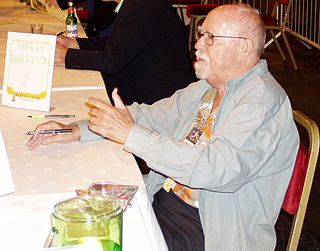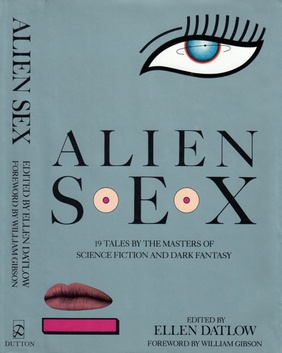Related Research Articles

Brian Wilson Aldiss was an English writer, artist and anthology editor, best known for science fiction novels and short stories. His byline reads either Brian W. Aldiss or simply Brian Aldiss, except for occasional pseudonyms during the mid-1960s.

Paul Myron Anthony Linebarger, better known by his pen-name Cordwainer Smith, was an American author known for his science fiction works. Linebarger was a US Army officer, a noted East Asia scholar, and an expert in psychological warfare. Although his career as a writer was shortened by his death at the age of 53, he is considered one of science fiction's more talented and influential authors.

Iain Banks was a Scottish author, writing mainstream fiction as Iain Banks and science fiction as Iain M. Banks, adding the initial of his adopted middle name Menzies. After the success of The Wasp Factory (1984), he began to write full time. His first science fiction book, Consider Phlebas, appeared in 1987, marking the start of the Culture series. His books have been adapted for theatre, radio, and television. In 2008, The Times named Banks in their list of "The 50 greatest British writers since 1945".
The New Wave was a science fiction (SF) style of the 1960s and 1970s, characterized by a great degree of experimentation with the form and content of stories, greater imitation of the styles of non-science fiction literature, and an emphasis on the psychological and social sciences as opposed to the physical sciences. New Wave authors often considered themselves as part of the modernist tradition of fiction, and the New Wave was conceived as a deliberate change from the traditions of the science fiction characteristic of pulp magazines, which many of the writers involved considered irrelevant or unambitious.

James White was a Northern Irish author of science fiction novellas, short stories and novels. He was born in Belfast and returned there after spending some early years in Canada. After a few years working in the clothing industry, he worked at Short Brothers Ltd., an aircraft company based in Belfast, from 1965 until taking early retirement in 1984 as a result of diabetes. White married Margaret Sarah Martin, another science fiction fan, in 1955 and the couple had three children. He died of a stroke.

Harry Max Harrison was an American science fiction author, known mostly for his character The Stainless Steel Rat and for his novel Make Room! Make Room! (1966). The latter was the rough basis for the motion picture Soylent Green (1973). Long resident in both Ireland and the United Kingdom, Harrison was involved in the foundation of the Irish Science Fiction Association, and was, with Brian Aldiss, co-president of the Birmingham Science Fiction Group.

Christopher Priest is a British novelist and science fiction writer. His works include Fugue for a Darkening Island, The Inverted World, The Affirmation, The Glamour, The Prestige, and The Separation.

Science Fantasy, which also appeared under the titles Impulse and SF Impulse, was a British fantasy and science fiction magazine, launched in 1950 by Nova Publications as a companion to Nova's New Worlds. Walter Gillings was editor for the first two issues, and was then replaced by John Carnell, the editor of New Worlds, as a cost-saving measure. Carnell edited both magazines until Nova went out of business in early 1964. The titles were acquired by Roberts & Vinter, who hired Kyril Bonfiglioli to edit Science Fantasy; Bonfiglioli changed the title to Impulse in early 1966, but the new title led to confusion with the distributors and sales fell, though the magazine remained profitable. The title was changed again to SF Impulse for the last few issues. Science Fantasy ceased publication the following year, when Roberts & Vinter came under financial pressure after their printer went bankrupt.
Charles Leonard Harness was an American science fiction writer.

Non-Stop is a 1958 science fiction novel by British writer Brian Aldiss. It is about problems that the inhabitants of a huge generation space ship face after an alien amino acid that they picked up on another planet triggers a pandemic. Law and order began to collapse, and knowledge of the ship and of its purpose was eventually almost entirely lost throughout the vessel.

Farewell, Fantastic Venus is a 1968 American science fiction anthology edited by Brian Aldiss and Harry Harrison. An abridged version was published in the same year under the title All About Venus. It was first published as a direct response to the information returned from the first space probes sent to Venus, especially the first atmospheric probe to return data, Venera 4. The first data was not returned from the surface until Venera 7 successfully landed in 1970.

Hothouse is a 1962 science fiction novel by British writer Brian Aldiss, composed of five novelettes that were originally serialised in The Magazine of Fantasy & Science Fiction in 1961. In the US, an abridged version was published as The Long Afternoon of Earth; the full version was not published there until 1976.
Paul Kincaid is a British science fiction critic.

Report on Probability A is a science fiction novel by Brian Aldiss. The novel was completed in 1962 and published in 1967 in New Worlds after first being rejected by publishers in the United Kingdom, France and the United States. Report on Probability A has been described as an antinovel. It is a seminal work in the British New Wave of experimental science fiction that began appearing in New Worlds following the appointment of Michael Moorcock as editor in 1964. A revised and extended version was published by Faber and Faber in 1968 and Doubleday in 1969. New Worlds described it as "perhaps [Aldiss'] most brilliant work to date".

Nebula Science Fiction was the first Scottish science fiction magazine. It was published from 1952 to 1959, and was edited by Peter Hamilton, a young Scot who was able to take advantage of spare capacity at his parents' printing company, Crownpoint, to launch the magazine. Because Hamilton could only print Nebula when Crownpoint had no other work, the schedule was initially erratic. In 1955 he moved the printing to a Dublin-based firm, and the schedule became a little more regular, with a steady monthly run beginning in 1958 that lasted into the following year. Nebula's circulation was international, with only a quarter of the sales in the United Kingdom; this led to disaster when South Africa and Australia imposed import controls on foreign periodicals at the end of the 1950s. Excise duties imposed in the UK added to Hamilton's financial burdens, and he was rapidly forced to close the magazine. The last issue was dated June 1959.

Greybeard is a science fiction novel by British author Brian Aldiss, published in 1964.

The Moment of Eclipse is a 1970 collection of science fiction short stories written by Brian Aldiss between 1965 and 1970. It was originally published by Faber & Faber. In 1972, the collection, in its entirety, received the first BSFA Award for short fiction published in 1970-71.

"And I Awoke and Found Me Here on the Cold Hill's Side" is a science fiction short story by American author James Tiptree, Jr. Originally published in The Magazine of Fantasy & Science Fiction, the short story has been republished in several anthologies.

Nebula Award Stories 1965 is an anthology of science fiction short works edited by Damon Knight. It was first published in hardcover by Doubleday in 1966, with a Science Fiction Book Club edition following in October of the same year. The first British edition was published by Gollancz in 1967. Paperback editions followed from Pocket Books in the U.S. in November 1967, and New English Library in the U.K. in April 1969. The U.K. and paperback editions bore the variant title Nebula Award Stories 1. The book was more recently reissued by Stealth Press in hardcover in February 2001. It has also been published in German.
The Saliva Tree is a science fiction novella by British writer Brian W. Aldiss first published in the September 1965 issue of The Magazine of Fantasy and Science Fiction. It won the 1965 Nebula Award for Best Novella.
References
- ↑ Kincaid, Paul. "A Timeline of British Science Fiction 1800–1899". Paul Kincaid, Author, Critic. Retrieved 1 June 2018.
- ↑ "General Record of British and Foreign Literature" (PDF). The Publishers' Circle. XLV (1087). 30 December 1882.
- ↑ Post, Jonathan V. "AI in Space". Computer Futures - Space Publications. Retrieved 1 June 2018.
Vulcan supposedly orbited the sun entirely within the orbit of Mercury. It was fictionally visited in ["Nunsowe Green", A Thousand Years Hence, 1882].
- ↑ Aldiss, Brian (1966). The Saliva Tree. London: Faber & Faber. p. 8.